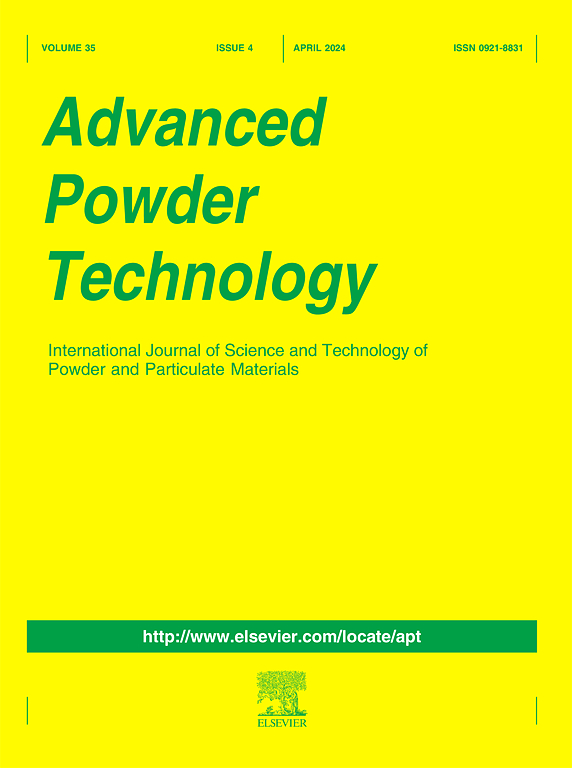Direct surface modification of a silica-based adsorbent for CO2 capture from coir fibers dissolved in a sulfur-free alkali-urea system
IF 4.2
2区 工程技术
Q2 ENGINEERING, CHEMICAL
引用次数: 0
Abstract
The direct surface modification of silica using cellulose-based organosilane dissolved in a sulfur-free NaOH/urea solvent system was further investigated as a selective CO2 adsorbent. Cellulose was dissolved at a low temperature of − 5°C, followed by mixing a silicate precursor as a silica source. Cellulose–carbamat complex grafting was carried out through a silica monomer condensation reaction using the sol–gel method. The anionic surfactant sodium lauryl sulfate (SLS) was added at various concentrations as a template to improve the particles’ physical characteristics. The process of particle formation and template removal was carried out in one stage in a spray drying system that followed the one droplet to one particle rule. Increasing the SLS concentration indicates a change in particle morphology from spherical to hollow, followed by an increase in particle size with a more uniform size distribution. The surface area and porosity of silica particles increased by up to fivefold when the SLS concentration was increased to 3 CMC. The physical characteristics that significantly increase show a linear influence on their ability to adsorb CO2. At a pressure of 6 bar, the CO2 gas adsorption capacity of the silica adsorbent with the SLS 3 CMC template was almost eight times greater than that with the SLS 3 CMC template, reaching 12.85 mmol/g silica.

二氧化硅基吸附剂的直接表面改性,用于从溶解在无硫碱-尿素体系中的椰子纤维中捕获二氧化碳
研究了纤维素基有机硅在无硫氢氧化钠/尿素溶剂体系中作为选择性CO2吸附剂对二氧化硅的直接表面改性。纤维素在- 5°C的低温下溶解,然后混合硅酸盐前驱体作为二氧化硅源。采用溶胶-凝胶法,通过硅单体缩合反应进行纤维素-氨基丁酸络合物接枝。以不同浓度的阴离子表面活性剂十二烷基硫酸钠(SLS)为模板剂,改善颗粒的物理特性。在遵循一滴一粒原则的喷雾干燥系统中,颗粒形成和模板去除过程在一个阶段完成。随着SLS浓度的增加,颗粒形貌由球形变为空心,颗粒尺寸增大,粒径分布更加均匀。当SLS浓度增加到3 CMC时,二氧化硅颗粒的表面积和孔隙率增加了5倍。显著增加的物理特性对其吸附CO2的能力表现出线性影响。在6 bar压力下,SLS 3 CMC模板的二氧化硅吸附剂对CO2气体的吸附量几乎是SLS 3 CMC模板的8倍,达到12.85 mmol/g二氧化硅。
本文章由计算机程序翻译,如有差异,请以英文原文为准。
求助全文
约1分钟内获得全文
求助全文
来源期刊

Advanced Powder Technology
工程技术-工程:化工
CiteScore
9.50
自引率
7.70%
发文量
424
审稿时长
55 days
期刊介绍:
The aim of Advanced Powder Technology is to meet the demand for an international journal that integrates all aspects of science and technology research on powder and particulate materials. The journal fulfills this purpose by publishing original research papers, rapid communications, reviews, and translated articles by prominent researchers worldwide.
The editorial work of Advanced Powder Technology, which was founded as the International Journal of the Society of Powder Technology, Japan, is now shared by distinguished board members, who operate in a unique framework designed to respond to the increasing global demand for articles on not only powder and particles, but also on various materials produced from them.
Advanced Powder Technology covers various areas, but a discussion of powder and particles is required in articles. Topics include: Production of powder and particulate materials in gases and liquids(nanoparticles, fine ceramics, pharmaceuticals, novel functional materials, etc.); Aerosol and colloidal processing; Powder and particle characterization; Dynamics and phenomena; Calculation and simulation (CFD, DEM, Monte Carlo method, population balance, etc.); Measurement and control of powder processes; Particle modification; Comminution; Powder handling and operations (storage, transport, granulation, separation, fluidization, etc.)
 求助内容:
求助内容: 应助结果提醒方式:
应助结果提醒方式:


